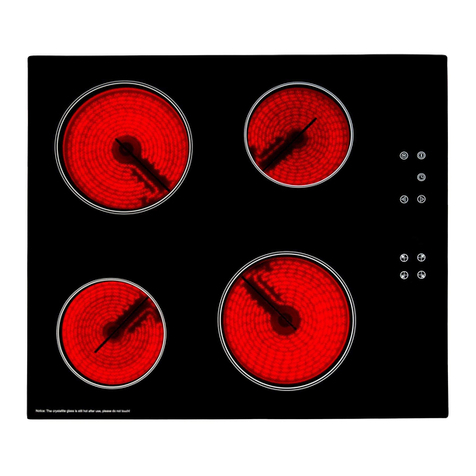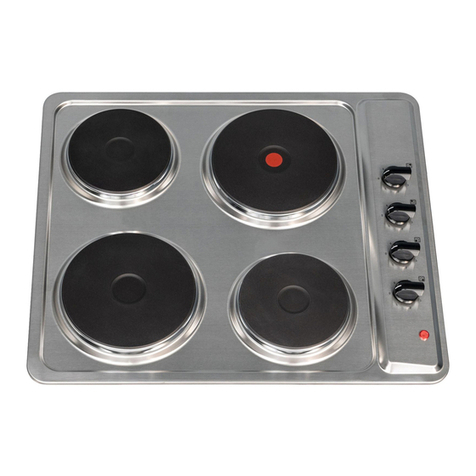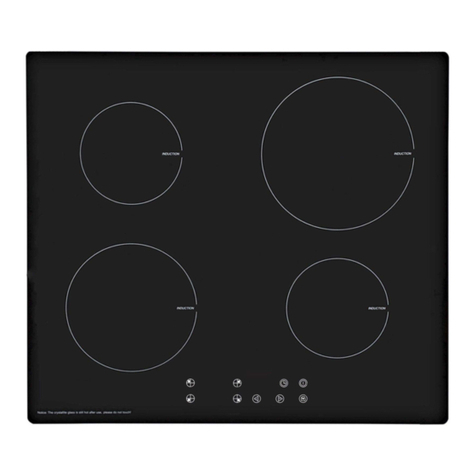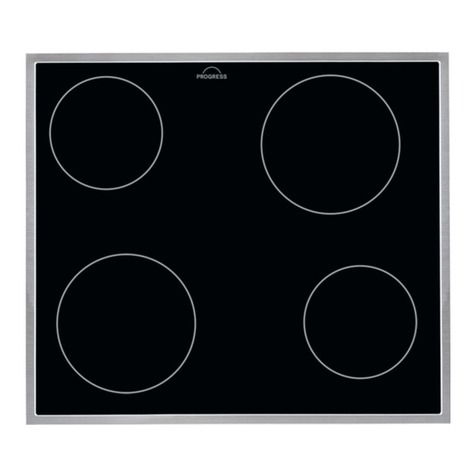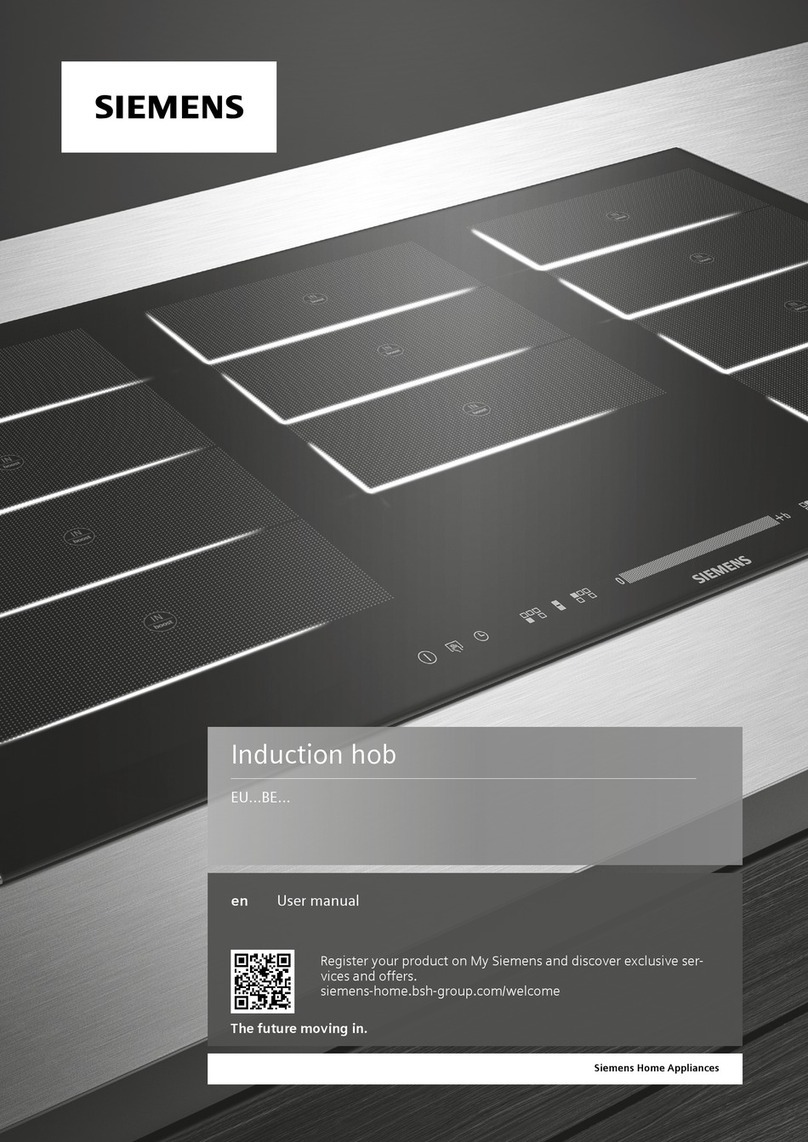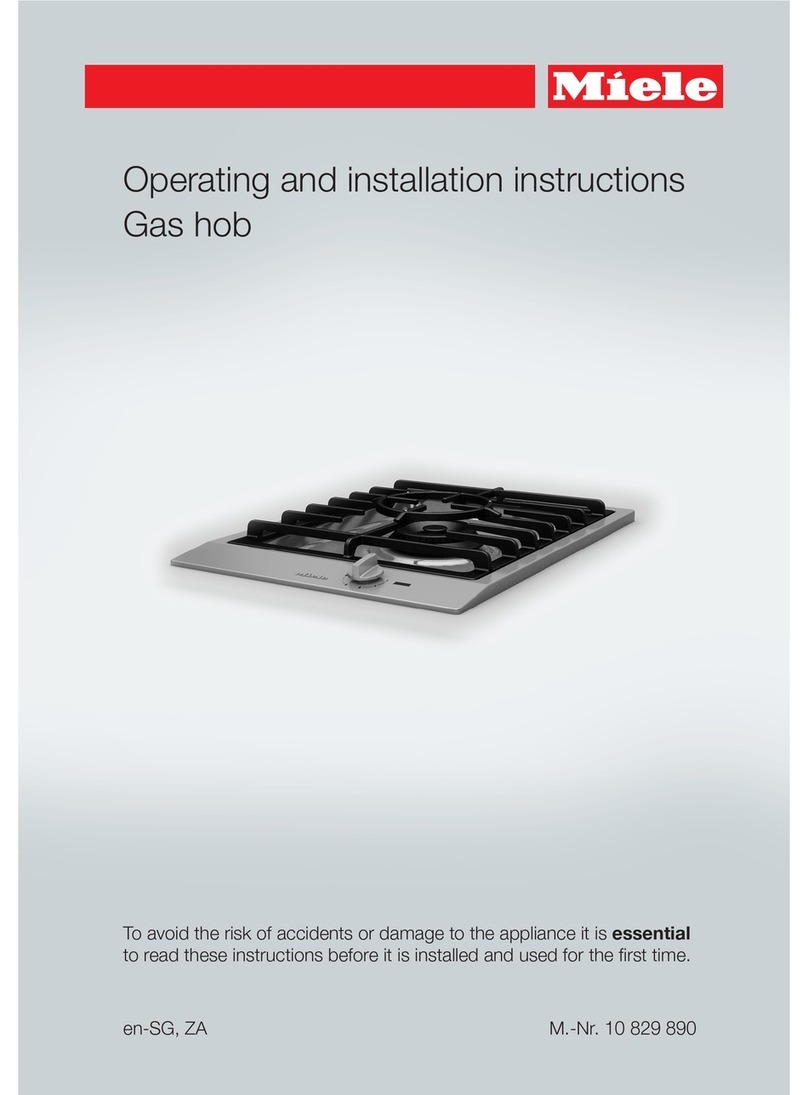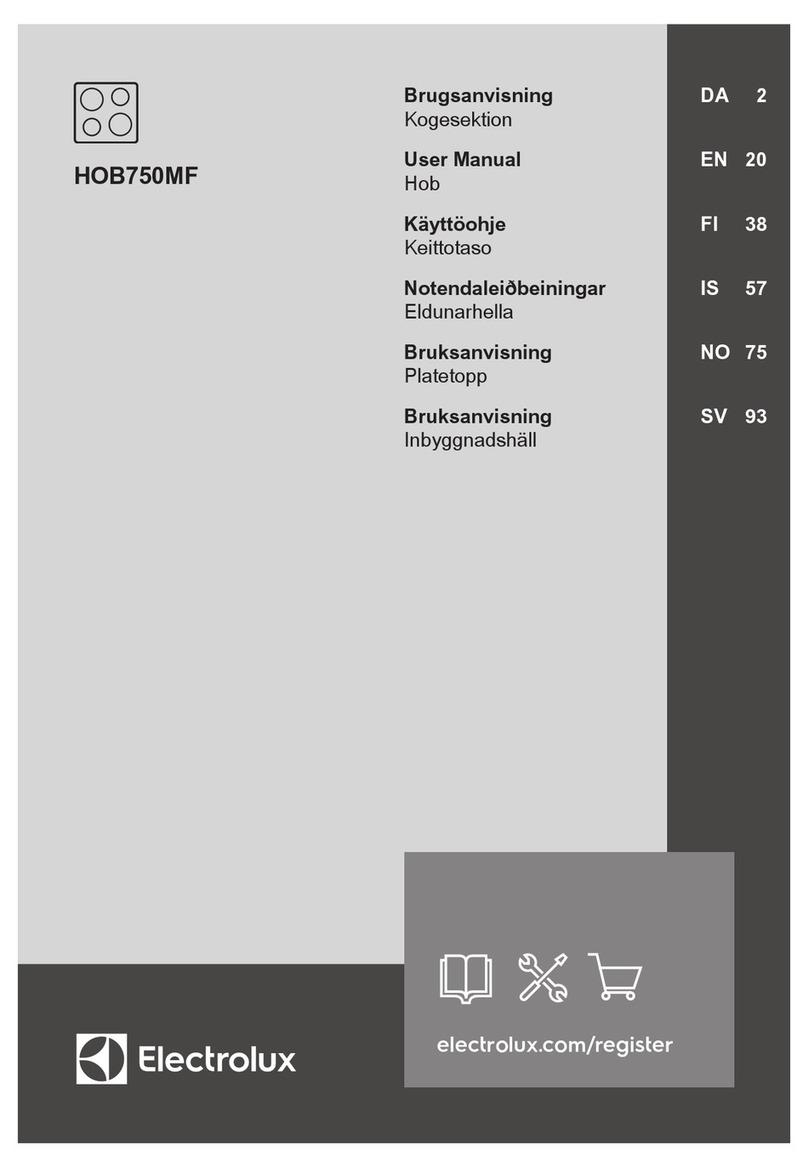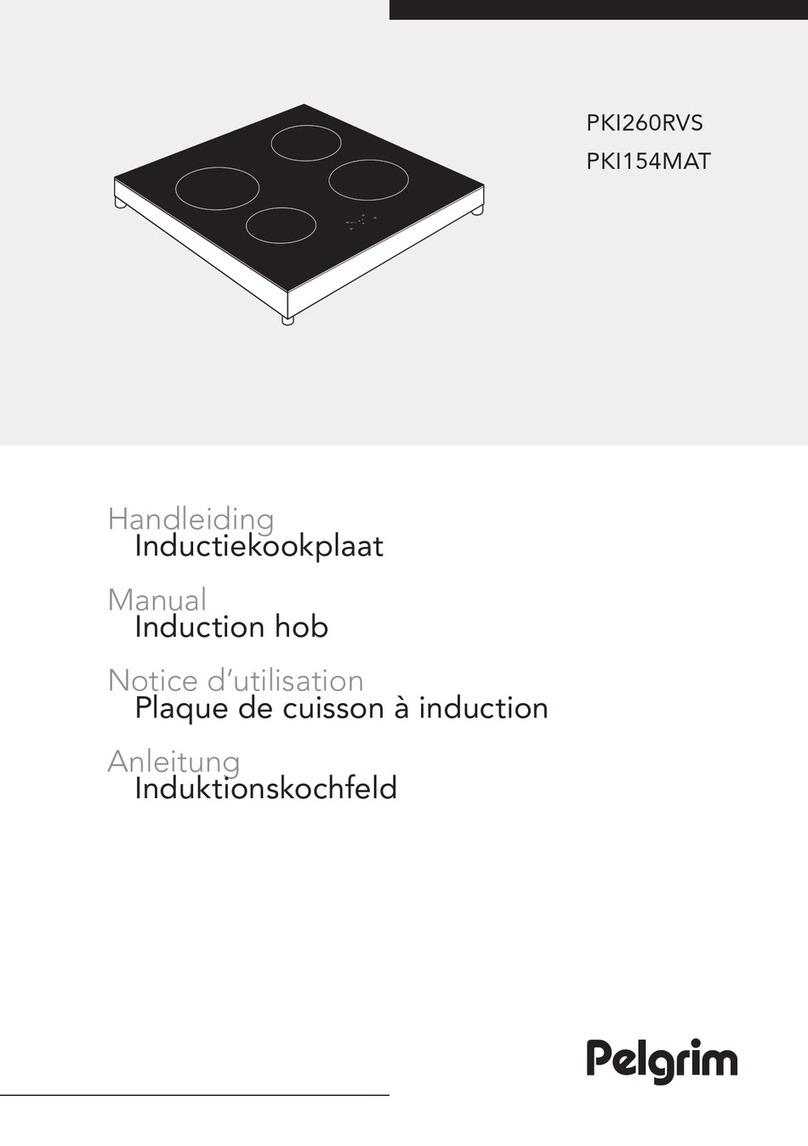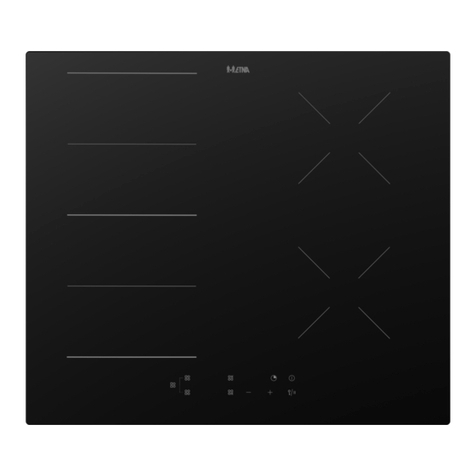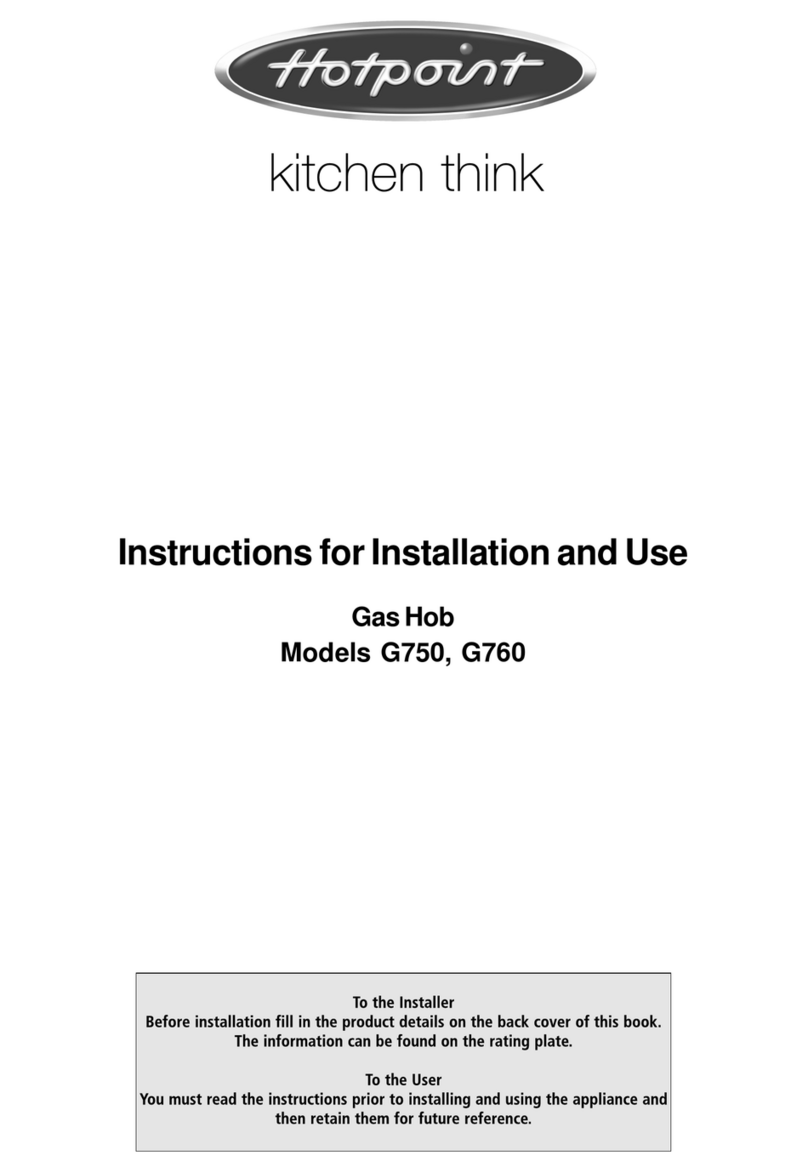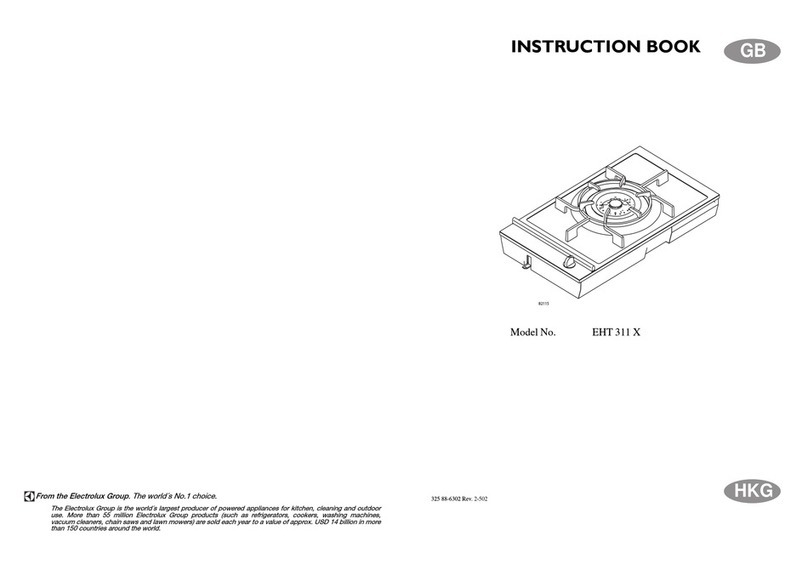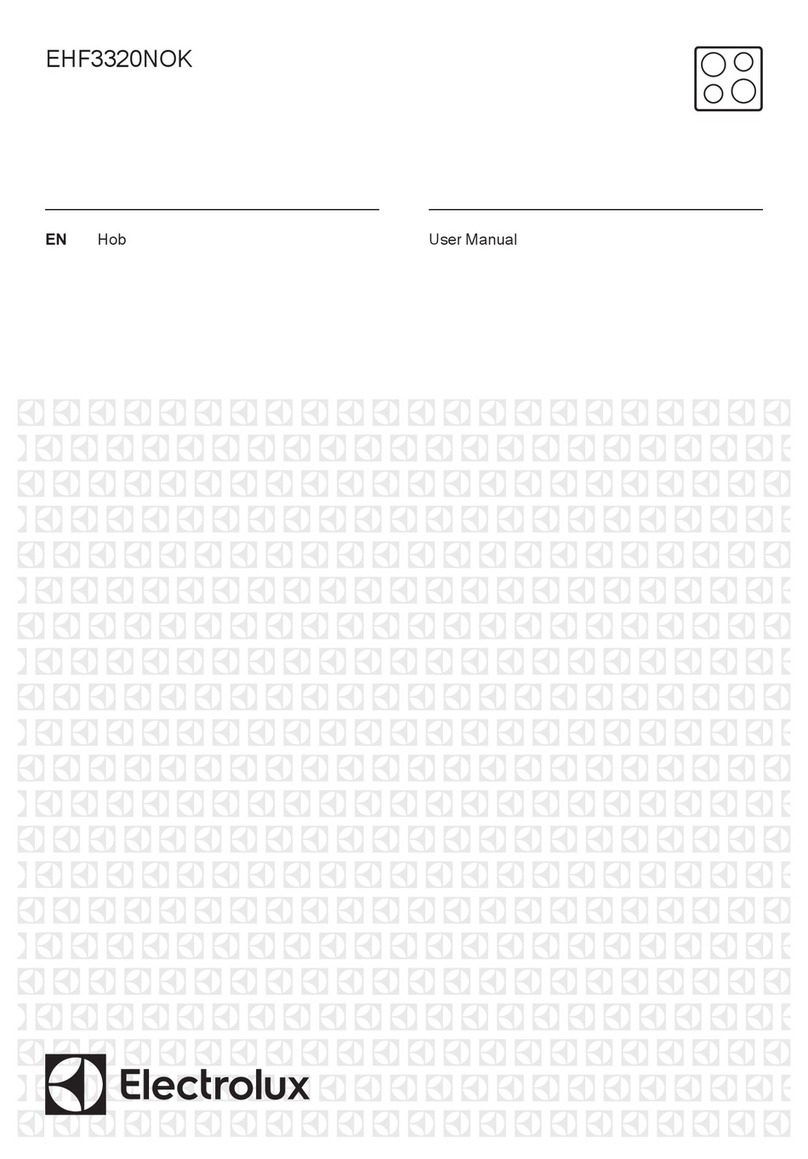SIA IHDR80BL Reference manual

Cod:
Downdraft Induction Hob
Manual for Installation, Use and Maintenance
P154XINDH

2
Please read the instruction manual carefully before operating your new downdraft induction hob.
We recommend that you spend some time to read this Instruction / Installation Manual in order to fully understand how
to correctly install and operate it.
Read all the safety instructions carefully before use and keep this Instruction / Installation Manual for future reference.
Safety Warnings
Your safety is important to us. Please read this information before using the appliance.
Installation
Electrical Shock Hazard
• Disconnect the appliance from the mains electricity supply before carrying out any work or maintenance on it.
• Connection to a good earth wiring system is essential and mandatory.
• Alterations to the domestic wiring system must only be made by a qualified electrician.
• Failure to follow this advice may result in electrical shock or death.
Cut Hazard
• Take care - panel edges are sharp.
• Failure to use caution could result in injury or cuts.
Important Safety Instructions
• Read these instructions carefully before installing or using this appliance.
• No combustible materials or products should be placed on this appliance at any time.
• Please make this information available to the person responsible for installing the appliance.
• In order to avoid a hazard, this appliance must be installed according to these instructions for installation.
• This appliance must be installed and earthed only by a suitably qualified person.
• This appliance should be connected to a circuit which incorporates an isolating switch, providing full disconnection
from the power supply.
• Failure to install the appliance correctly could invalidate any warranty or liability claims.
Operation and Maintenance
Electrical Shock Hazard
Do not cook on a broken or cracked hob. If the hob surface should break or crack, immediately switch off the
appliance at the mains power supply (wall switch) and contact a qualified technician.
• Turn off the hob at the wall switch before cleaning or maintenance.
• Failure to follow this advice may result in electrical shock or death.
Health Hazard
• This appliance complies with electromagnetic safety standards.
• However, persons with cardiac pacemakers or other electrical implants (such as insulin pumps) must consult with their
doctor or implant manufacturer before using this appliance to make sure that their implants will not be affected by the
electromagnetic field.
• Failure to follow this advice may result in death.
Hot Surface Hazard
• During use, the appliance becomes hot. Care should be taken to avoid touching the heating elements.
• Do not let your body, clothing or any item other than suitable cookware contact the induction glass until the surface is
cool.
• Metallic objects such as knives, forks, spoons and lids should not be placed on the hob surface since they can get
hot.
• Keep children away.
• Handles of saucepans may be hot to touch. Ensure that the saucepan handles do not overhang other cooking zones
that are switched on. Make sure children can’t reach the cookware handles.
• Failure to follow this advice could result in burns and scalds.

3
IMPORTANT SAFETY INSTRUCTIONS
• Never leave the appliance unattended when in use. Boil-over causes smoking and greasy spillovers may ignite.
• Never use your appliance as a work or storage surface.
• Never leave any objects or utensils on the appliance.
• Do not place or leave any magnetisable objects (e.g. credit cards, memory cards) or electronic devices (e.g.
computers, MP3 players) near the appliance as they may be affected by its electromagnetic field.
• Never use your appliance for warming or heating the room.
• After use, always turn off the cooking zones and the hob as described in this manual (i.e. by using the touch controls).
Do not rely on the pan detection feature to turn off the cooking zones when you remove the pans.
• Do not allow children to play with the appliance nor sit, stand or climb on it.
• Do not store items of interest to children in cabinets above the appliance. Children climbing on the cooktop could be
seriously injured.
• Do not leave children alone or unattended in the area where the appliance is in use.
• Children or persons with a disability which limits their ability to use the appliance should have a responsible and
competent person to instruct them in its use. The instructor should be satisfied that they can use the appliance without
danger to themselves or their surroundings.
• Do not repair or replace any part of the appliance unless specifically recommended in the manual. All other servicing
should be done by a qualified technician.
• Do not use a steam cleaner to clean your hob.
• Do not place or drop heavy objects on your hob.
• Do not stand on your hob.
• Do not use pans with jagged edges or drag pans across the induction glass surface as this can scratch the glass.
• Do not use scourers or any other harsh abrasive cleaning agents to clean your hob as these can scratch the
induction glass.
•This appliance is intended to be used in a household or similar environments such as staff kitchen areas in shops,
offices and other residential environments.
• If the supply cord is damaged, it must be replaced by the manufacturer, its service agent or a similarly qualified
person in order to avoid a hazard.
•WARNING: The appliance and its accessible parts become hot during use.
Care should be taken to avoid touching the heating elements.
Children less than 8 years of age should be kept away unless continuously supervised.
•This appliance can be used by children aged 8 and above and persons with reduced physical, sensory or mental
capabilities or lack of experience and knowledge, if they have been given supervision or instructions concerning the
use of the appliance in a safe way and understand the hazards involved.
•WARNING: Unattended cooking on the hob with fat or oil can be dangerous and may result in a fire. NEVER try to
extinguish such fire with water, rather switch off the appliance and then cover the flame with a lid or a fire blanket.
•WARNING: Do not store items on the cooking surfaces as this presents a fire hazard.
•WARNING: If the surface is cracked, switch off the appliance to avoid the possibility of an electric shock.
•The appliance is not intended to be operated by means of an external timer or separate remote-control system.
•WARNING: In order to prevent movement of the appliance, it must be stabilised prior to installation. Please refer to
the installation instructions.
•WARNING:Only use hob guards that are either provided or deemed suitable by the manufacturer for use with this
induction hob. The use of inappropriate guards can cause accidents.
This appliance incorporates an earth connection for functional purposes only.
•WARNING: Danger of fire: do not store items on the cooking surfaces.
•CAUTION: The cooking process has to be supervised. A short term cooking process has to be supervised
continuously.
NOTICE: The crystallite glass is still hot after use, please do not touch!

IMPORTANT INFORMATION FOR THE CORRECT DISPOSAL OF THE PRODUCT, IN ACCORDANCE WITH EC
DIRECTIVE 2012/19/EC.
Check and empty the water retainer regularly to avoid it overflowing.
4
Under no circumstances should any external covers be removed for servicing or maintenance, except by suitably
qualified personnel.

5
E & O E. All instructions, dimensions and illustrations are provided for guidance only. SIA reserves the
right to change specifications without prior notice.
Attribute Symbol Value Units
Annual Energy Consumption AEC 64.0
1.5
15.1
80.4
304
116.9
N/A
N/A
N/A
N/A
0.35
70
Hood kWh
Time Increase factor f
FDEHood
EEIHood
Measured Pressure at Best PBEP Pa
Measured Electric Power at Best WBEP W
Nominal Lighting Power WL W
Average Illumination of the
lighting system on the cooking
surface
EMiddle Lux
Measured Power Consumption in
standby
PSW
Measured Power Consumption POW
Noise Level LWA dBA
GFEHood %
45.4
LEHood %
TECHNICAL DATA
Model Power supply Size (mm) Built-in hole
Size (mm)
2000W 1500W
2000W1500W
Power
Heating area
rear left
(180mm)
Heating area
front right
(140mm)
Heating area
front left
(180mm)
Heating area
rear right
(180mm)
AC 220-240V
50Hz 800x520x62 780x500
IHDR80BL

USING YOUR EXTRACTOR
Induction hob
1. Heating zone selection
2. Power level / Timer adjustment
3. Lock
4. Power ON/OFF
5. Timer
6. Bridge zone selection
Downdraft extractor
7.-8. Extraction speed adjustment
9. Power ON/OFF
10. Delay
1
32
4
5
6
Before Using Your New Induction Hob
• Read this guide, taking special note of the ‘Safety Warnings’ section.
• Remove any protective film that may still be on your induction hob.
Using the Touch Controls
• The controls respond to touch so you don’t need to apply any pressure.
• Use the ball of your finger, not its tip.
• You will hear a beep each time a touch is registered.
• Make sure the controls are always clean, dry and that there are no objects (e.g. a utensil or a cloth) covering them.
rate.
6
USING YOUR INDUCTION HOB
1. Power ON/OFF: Touch this key to turn the extractor on, the digital display will show “0”. Touch this key again to
2. Delay key: When this key is pressed, the extractor will continue to work for 1 minute before turning off.
The delay key will flash to indicate the extractor is in the “delay” mode. To exit this mode, press the key again.
.
3. Extraction speed adjustment keys: Once the appliance has been turned on, touch the + key, the display will show
“1” and the extractor will operate on low speed. Press this key again for medium and high speed operation, the
digital display will show “2” and “3” respectively. When in high or medium speed operation, press – key to reduce
the speed level.
PRODUCT OVERVIEW
Top View
8
10
7
9
Due to power limitation:
2000W zone 2000W zone
1500W zone 1500W zone
The power of the two left heating zones is limited to 3400W. Therefore, simultaneous operation of
both of these zones allows one zone to be set to a maximum level of “9” and the other to a
maximum level of “8”. Same power limitation applies to the right two heating zones.

Choosing the Right Cookware
• Only use cookware with a base suitable for induction cooking. Look for the induction symbol on the packaging or on
the bottom of the pan.
• You can check whether your cookware is suitable by carrying out a magnet test. Move a magnet towards the base
of the pan. If it is attracted, the pan is suitable for induction.
• If you do not have a magnet:
1. Put some water in the pan you want to check.
2. If “ ” does not flash in the display and the water is heating, the pan is suitable.
• Cookware made from the following materials is not suitable: pure stainless steel, aluminium or copper without a
magnetic base, glass, wood, porcelain, ceramic and earthenware.
Do not use cookware with jagged edges or a curved base.
Make sure that the base of your pan is smooth, sits flat on the glass and is the same size as the cooking zone. Using a
pot that is slightly wider means energy will be used at its maximum efficiency. If you use a smaller pot, efficiency could
be less than expected. Pots with a diameter of less than 140 mm could be undetected by the hob if placed on the
larger cooking zone. Always centre your pan on the cooking zone.
Always lift pans off the induction hob – do not slide as they may scratch the glass.
7
Good Bad Bad Bad Bad Bad Bad
(recessed base) (convex base) (undersize) (oversize) (moisture on hotplate) (no utensil)
To Start Cooking
1. Touch the ON/OFF control.
With the power switched on, the buzzer will beep once, all displays will show “ – “ or “ – – “, indicating that
the induction hob has entered standby mode.
2. Place a suitable pan on the cooking zone that you wish to use.
• Make sure the bottom of the pan and the surface of the cooking zone are clean and dry.
3. Touch the heating zone selection control and the indicator next to the key will flash.
4. Select a heat setting by touching the “-“ or “+” control.
If you don’t choose a heat setting within 1 minute, the induction hob will automatically switch off. You will
need to start again at step 1.
• You can touch the heating zone selection again and modify the heat setting at any time during cooking.
!
If the Display Flashes “ ” Alternately with the Heat Setting
This means that:
• you have not placed a pan on the correct cooking zone or,
• the pan you’re using is not suitable for induction cooking or,
• the pan is too small or not properly centred on the cooking zone.
No heating takes place unless there is a suitable pan on the cooking zone.
The display will automatically turn off after 1 minute if no suitable pan is placed on it.
When You Have Finished Cooking
1. Touch the heating zone selection control that you wish to switch off.
2. Turn the cooking zone off by scrolling down to”0” . Make sure the display shows“0” and then “H”.
Turn the hob off by touching the ON/OFF control.
4. Beware of hot surfaces indicator “H” will show which cooking zone is hot to touch. It will disappear when the
surface has cooled down to a safe temperature. It can also be used as an energy saving function - if you want
to heat further pans, use the hotplate that is still hot.
6
H
0
or

8
Power level
Default working time (hour)
1
8
2
8
3
8
4
4
5
4
6
4
7
2
8
2
9
2
Locking the Controls
• You can lock the controls to prevent unintended use (for example children accidentally turning the cooking zones
on).
• When the controls are locked, all the controls except the ON/OFF control are disabled.
To lock the controls:
Touch the lock key. The timer indicator will show “Lo”.
To unlock the controls:
1. Make sure the induction hob is turned on.
2. Touch and hold the lock key for a while.
3. You can now start using your induction hob.
When the hob is in lock mode, all controls are disabled, except the ON/OFF. You can always turn the induction hob off
with the ON/OFF control in an emergency, but you would have to unlock the hob first in the next operation.
Overheating Protection
The appliance is equipped with a temperature sensor which can monitor the temperature inside the induction hob.
When an excessive temperature is monitored, the induction hob will stop operation automatically.
Detection of Small Articles
When an unsuitably sized or non-magnetic pan (e.g. aluminium), or some other small item (e.g. knife, fork, key) has been
left on the hob, the display flashes “ ” and the hob will automatically go into standby mode in 1 minute. The fan will
keep cooling down the induction hob for a further 2 minutes.
Auto Shutdown Protection
Auto shutdown is a safety protection function for your induction hob. It will automatically turn off after a certain period of
time. The default working times for various power levels are shown in the below table:
!
When a pot is removed, the induction hob can stop heating immediately and automatically switch off after 1 minute.
People with a heart pacemaker should consult their doctor before using this unit.
Using the Timer
• You can set it to turn one cooking zone off after the set time is up.
• You can set the timer up to 99 minutes.
Setting the Timer to Turn off One Cooking Zone
1. Touch the heating zone selection control that you want to set the timer for.
2. Touch timer control, the minder indicator will start flashing and “30” will show in the timer display.
3. Set the time by touching the “+” and “-” buttons.
Hint: Touch the “-“ or “+” control of the timer once - time will decrease or increase by 1 minute.
Touch and hold the ”-“ or “+” control of the timer - time will decrease or increase by 10 minutes.
4. Touch the “-” control to reduce the time outstanding to zero or press the “timer control” when “00”
shows in the minute display to cancel the timer.
5. When the time is set, it will begin to count down immediately. The display will show the remaining time and the
timer indicator will flash for 5 seconds.
NOTE: The red dot next to power level indicator will illuminate, indicating that zone is selected.
NOTE: Timer display will show the shortest set time of the selected zones. The cooking zone with the
shortest set time will be indicated by a flashing red dot next to the power level.
6. When cooking timer expires, the corresponding cooking zone will switch off automatically.
!Other cooking zones will keep operating if they have been turned on previously.
6
30
--
36
6.
00

9
Heat setting Suitability
1-2
3-4
5-6
7-8
9
● Delicate warming for small amounts of food
● Melting chocolate, butter, and foods that burn quickly
● Gentle simmering ● Slow warming
● Reheating ● Rapid simmering ● Cooking rice
Pancakes
● Cooking pasta
● Stir-frying ● Searing ● Bringing soup to the boil ● Boiling water
Heat Settings
The settings below are guidelines only. The exact setting will depend on several factors, including your cookware and
the amount you are cooking. Experiment with the induction hob to find the settings that best suit you.
Using the Bridge Zone (Maximum Power 3000W)
To Turn On a Bridge:
1. Touch the bridge selection key to turn this zone on. Indicator to the right of the bridge zone selection key will be
illuminated. The heat setting levels for the cooking zones within the bridge will default to “0” and can be set from a
minimum of “1” to a maximum of “9”. Any previously set timers for these cooking areas will turn off and 2 dashes “--"
will appear in the timer display.
2. Touch the Power level / Timer adjustment keys to change the setting. The selected heat setting will show in the
heat level display for each cooking area within the bridge zone.
To Turn Off a Bridge:
To turn the bridge zone off, touch the bridge zone selection key.
The bridge cooking areas will resume operation as 2 separate areas.
!
Cooking Guidelines
Take care when frying as the oil and fat heat up very quickly. At extremely high temperatures oil and fat
will ignite spontaneously and this presents a serious fire risk.
CARE AND CLEANING
1. Everyday soiling on glass (fingerprints, marks, stains left by food of non-sugary spillovers on the glass)
1) Switch off the power to the hob.
2) Apply a hob cleaner while the glass is still warm (but not hot).
3) Rinse and wipe dry with a clean cloth or paper towel.
4) Switch the power to the hob back on.
● When the power to the hob is switched off, there will be no hot surface indication but the cooking zones may
still be hot! Take extreme care.
● Heavy-duty or some nylon scourers and harsh/abrasive cleaning agents may scratch the glass surface, so
please do check that they are suitable for induction hob care before use.
● Never leave cleaning residue on the hob, the glass may become stained.
2. Boil-overs, melts and hot sugary spills on the glass
Remove these immediately with a palette knife or razor blade scraper suitable for induction hobs but
beware of hot cooking zone surfaces:
1) Switch off the power to the hob via the isolation switch.
2) Hold the blade or utensil at a 30° angle and scrape the soiling or spill to a cool area of the hob.
3) Clean up the soiling or spill with a dish cloth or paper towel.
4) Follow steps 2 to 4 for everyday soiling on glass above.
● Remove stains left by melts and sugary food or spillovers as soon as possible. If left to cool on the glass,
theymay be difficult to remove or even permanently damage the glass surface.
NOTE:
NOTE:

10
3. Spillovers on the touch controls
1) Switch off the power to the hob.
2) Soak up the spill.
3) Wipe the touch control area with a clean damp sponge or cloth.
4) Wipe the area completely dry with a paper towel.
5) Switch the power to the hob back on.
The hob may beep and turn itself off, and the touch controls may not function while there is liquid on them.
Make sure you wipe the touch control area dry before turning the hob back on.
NOTE:
HINTS AND TIPS
1. The induction hob cannot be turned on.
Make sure the induction hob is connected to the power supply and that it is switched on.
Check whether there is a power outage in your home or local area. If you’ve checked everything and the problem
persists, call a qualified technician.
2. The touch controls are unresponsive.
The controls are locked: Unlock the controls. See section “Using Your Induction Hob” for instructions.
3. The touch controls are difficult to operate.
There may be a slight film of water over the controls or you may be using the tip of your finger when touching the
controls: Make sure the touch control area is dry and use the ball of your finger when touching the controls.
6. The induction hob makes a low humming noise when used on a high heat setting.
This is caused by the technology of induction cooking: This is normal, the noise should quieten down or disappear
completely when you decrease the heat setting.
7. Fan noise coming from the induction hob.
A cooling fan built into your induction hob has come on to prevent the electronics from overheating. It may continue
to run even after you’ve turned the induction hob off: This is normal and needs no action. Do not switch the power to
the induction hob off at the wall while the fan is running.
8. Pans do not become hot and “ ” appears in the display.
The induction hob cannot detect the pan because it is not suitable for induction cooking. The induction hob cannot
detect the pan because it is too small for the cooking zone or not properly centred on it: Use cookware suitable for
induction cooking. See section “Choosing the Right Cookware”.
Centre the pan and make sure that its base matches the size of the cooking zone.
9. The induction hob or a cooking zone has turned itself off unexpectedly, a tone sounds and an error
code is displayed (typically alternating with one or two digits in the cooking timer display).
Technical fault: Please note down the error letters and numbers, switch the power to the induction hob off at the wall,
and contact a qualified technician.
4. The glass is being scratched.
Tough-edged cookware; unsuitable, abrasive scourer or cleaning products being used: Use cookware with flat and
smooth bases. See “Choosing the Right Cookware” and “Care and Cleaning” for further advice.
5. Some pans make crackling or clicking noises.
This may be caused by the construction of your cookware (layers of different metals vibrating differently): This is normal,
the noise should quieten down or disappear completely.

11
EXTRACTOR TROUBLESHOOTING
You observe that Possible causes What should you do?
The hood does not work -There is a power outage.
-Wire connectors are faulty or
have disconnected.
-Check power supply.
-Check orientation and
security of connectors.
-Check the power supply.
-Check circuit breaker or fuse.
-Try a more powerful
speed setting.
-Ensure adequate air intake
into kitchen.
-Replace charcoal filter.
-Remove any obstructions
from ducting.
-Ensure flaps can move freely.
-There is a power outage.
-The circuit breaker or fuse has tripped.
present.
-Inadequate ventilation in kitchen.
-Charcoal filter (if fitted) is blocked.
-Exit ducting is obstructed.
-Exit flaps on motor housing are
restricted.
The output is low
The hood stops mid operation
FAILURE DISPLAY AND INSPECTION
If an abnormality comes up, the induction hob will automatically enter the protective state and display
corresponding protective codes:
The above are the judgment and inspection of common failures.
Please do not disassemble the unit by yourself to avoid any danger or damage to the downdraft induction
hob.
Problem
U
Possible causes What to do
The appliance
does not work Break in power supply
Check that power supply is turned on at the socket. If there is a neon light on the socket,
check that this is illuminated. If the neon is not illuminated, check the consumer unit to see
if the MCB or fuse has tripped. If there is a blown fuse, replace it with a new one. If the MCB
has tripped, put it back in the “on” position. If the hob is of a wire connection type,
disconnect the power, check if the wire is loose and if so, rectify. If the above checks have
been carried out and the problem persists, a service is required.
During heating,
the unit stops
working
The timer has been set
No pan or pan unsuitable
Input power too low
Input power too high
Thermistor of coil short circuit.
Thermistor of coil open circuit.
Too high temperature of
the IGBT thermistor.
Too high temperature
of coil thermistor.
IGBT thermistor short circuit
IGBT thermistor open circuit
r a set penod of time, once
specific time, do not set the timer.
Ensure a compatible pan is being used. It must be suitable for induction cooking and not
too small for the zone that is being used to ensure it is detected by the hob. If the problem
persists, there may be a PCB synchronization or drive circuit fault, a service is required.
E2
E1
F3
F4
E5
E3
F9
FA
Low voltage, voltage of the main power is less than 180V. Please check if the voltage of
the main power is normal. Once the voltage has been normalised, re-start the unit. If the
problem persists, a service is required.
High voltage, voltage of the main power exceeds 250V. Please check if the voltage of the
main power is normal. Once the voltage has been normalised, re-start the unit. If the
problem persists, a service is required.
Connection error of the sensor of coil thermistor or failure of the detection part of the PCB
coil thermistor, a service is required.
Too high temperature of the IGBT thermistor indicates that the air outlet may be blocked.
Remove any obstructions and re-start the unit. If the problem persists, it is possible that the
cooling fan has a connection error or has failed; or it may indicate a failure of the drive
circuit of the fan, a service is required.
Too high temperature on induction glass surface, please check if the contents in the pan
have been overcooked by accidentally cooking for too long. Turn
cool down before turning it back on. If the problem persists, a service is required.
Connection error of the IGBT thermistor or failure of the detection part of IGBT PCB sensor,
a service is required.

12
600 800
520
404
800~1000
500
293
239
321
321
MIN.105
154
110
104
240
285
370 700
35
Fig.1
Fig.2
Accessory List
Installation Manual
Downdraft
Induction Hob
Overall installation size
1. ST4*10 screws
2. Aluminium tape
3. Rectangular aluminium
duct channels
4. Inlet grille
5. Grease filter
6. Extraction box
7. Water retainer
8. Motor
9. Adaptor
10. Induction hob
11. Fixing brackets
12. ST4*13 Screws
(for junction box)
13. ST3.5*8 Screws
(for fixing brackets)
111x
11
12
13
4x
4x
4x
4x
9
10
2
3
4
5
6
7
8

Fig.4
Fig.3
13
INDUCTION HOB INSTALLATION
L(mm) W(mm) H(mm) D(mm) A(mm) B(mm) X(mm)
800 520 62 56 780 500 50 min
A(mm) D E
600 Air intake Air exit ≥5mm
F
>35mm
G
<50mm
!
Cut out the work surface according to the sizes shown in the drawing.
For the purpose of installation and use, a minimum of 5cm space should be preserved around the hole.
Ensure the thickness of the work surface is at least 35mm. Please select a heat-resistant work surface material to avoid
deformation caused by the heat radiation from the hotplate.
Make sure the induction hob is well ventilated and the air inlet and outlet are not blocked. Ensure the induction hob is
in good working order.
Note: The distance between the hob and the cupboard above should be at least 600mm.
!
>2cm
Note: There must be a 560x5mm opening in the front
(position E) to dissipate the air.
After installation, ensure the airflow opening is
not blocked by the worktop.
Before you install the hob, make sure that:
• The work surface is square and level, and that no structural units interfere with the space requirements.
• The work surface is made of a heat-resistant material.
• The installation will comply with all clearance requirements and applicable standards and regulations.
• A suitable isolating switch providing full disconnection from the mains power supply is incorporated in the permanent
wiring, mounted and positioned to comply with the local wiring rules and regulations.
• The isolating switch must be of an approved type and provide a 3 mm air gap contact separation in all poles (or in all
active [phase] conductors if the local wiring rules allow for this variation of the requirements).
• The isolating switch will be easily accessible after installation.
• You consult local building authorities and by-laws if in doubt regarding installation.
• You use heat-resistant materials (such as ceramic tiles) for the wall surfaces surrounding the hob.
B
X
HD
LW
X
X
A
F
r
o
n
t
e
d
g
e
o
f
w
o
rk
t
o
p
R
e
a
r
w
a
l
l
SEAL
D
E
A
F
G

14
627
MIN.30
325
310
Fig. 6 Fan system cut-out size
Fan system hole size
EXTRACTOR INSTALLATION
When you have installed the hob, make sure that:
• The power supply cable is not accessible through cupboard doors or
drawers.
• There is adequate flow of fresh air from outside the cabinets to the base of
the hob.
• If the hob is installed above a drawer or cupboard space, the
temperature on the bottom of the hob may be too high. In order to prevent
injury or risk of fire, a thermal protection barrier must be installed below
the base of the hob.
• The isolating switch is easily accessible.
Before locating the fixing brackets
The unit should be placed on a stable, smooth surface to prevent damage.
Adjusting the bracket position
Secure the hob to the work surface using the brackets and screws provided (see Fig. 5).
Cautions
1. The induction hob must be installed by qualified personnel or technicians.
2. The hob must not be installed directly above a dishwasher, fridge, freezer, washing machine or a dryer as the humidity
may damage the hob electronics.
3. The induction hob must be installed in a way that better heat radiation can be ensured to enhance its reliability.
4. The wall and induced heating zone above the worksurface must withstand heat generated by the hob.
5. To avoid any damage, the sandwich layer and adhesive must be resistant to heat.
Fig.5
S
Worktop
Screw
Screw
Fixing bracket
Hob

Fig.7
Fan system installation instructions
①. Choose the required air outlet direction
of the fan system according to the position
of the flue and the cabinet. The 12 screws
on the left and right side plates of the fixed
fan can be removed and the adjustments
made in the direction of the arrow to change
the air outlet position.
Once the air outlet is in the desired
position, push the rectangular duct channel
onto the fan outlet and fix it with two ST4*10
screws at the corresponding positions. Seal
the connection with aluminium tape.
②.
15
Installing the fan system underneath the cabinet
Slide the fan system and ducting in place from the back of the cabinet so it’s positioned within the previously
made cut-out.
Fig.8

Fig.9 Fig.10
Installation of the adaptor and ducting
channel
Fix the ducting channel onto the adaptor with two
ST4 * 10 screws and then use the aluminium tape
to seal the connection.
Installation of the adaptor and ducting
channel
Align the four claws of the extraction box with the
long holes of the adaptor. Lift the extraction box
upwards to lock the claws in position and secure
the box to the adaptor with a ST4 * 10 screw.
Carefully rotate the claw underneath the extraction
box 180 degrees to ensure a tight fit to the adaptor.
16
Fig.11
X
Ducting channel installation instructions
Use a measuring tape to measure the distance “X” from the
worktop to the air inlet of the fan system.

Fig.12
X-50
X+15
Ducting channel installation instructions
Measure a distance of X (see Fig. 11) less 50mm
(X–50) from the upper edge of the extraction
box down along the ducting channel and cut
o the excess.
Stretch
Stretch the aluminium ducting channel to the
length of X + 15mm in order to connect it to
the fan system.
17
Fig.13
Installation instructions for the air duct
Align the assembled extraction box, adaptor and ducting channel with the hob from inside the cabinet and
secure in place with four ST4 * 10 screws.

Fig.14
Installation instructions for the air duct
Connect the other end of the ducting channel to the air inlet of the fan system, secure it in place with two
ST4 * 10 screws and seal with aluminium tape.
18
Fig.15
Wiring instructions
Plug the extractor power supply into the corresponding junction box socket and tighten.
Connect the power supply of the extractor.
Connect the fan system signal line to the extractor switch on the underside of the induction hob.
Once connected, fix the wires with a wiring harness (not included). Please note illustration is schematic (Fig. 15).
Make sure the wiring is secure.
Fix the junction box to the left side of the extraction box using ST4 * 13 screws in the accessory bag.
induction hob
power cable
junction box
induction hob
power cable
Main power cable
extractor power cable
Main power cable
extractor power
cable
signal line of
the fan system
switch line

Fig.16
Grease filter and inlet grille installation
Position the charcoal filter as well as the grease filter on the brackets inside the extraction box and then cover
the opening with the inlet grille.
Note: The charcoal filter is non-washable and must be replaced as required.
To ensure the best performance
from your extractor, the charcoal
filter should be replaced every
3-6 months, dependent on use.
Fig.17
19
Water retainer installation
Insert the water retainer horizontally from the right hand side, ensure it’s aligned with the extraction box and it is
stable. The water retainer needs to be checked and emptied regularly.
Grease filter
Carbon filter

Fig. 18 Replace the cabinet drawer(s) or door(s).
Finish installation
The method of connection is shown below.
20
MAINS ELECTRICITY CONNECTION
Connecting the downdraft induction hob to the mains power supply
This downdraft induction hob must be connected to the mains power supply only by a suitably qualified person.
Before connecting the downdraft induction hob to the mains power supply, check that:
1. The domestic wiring system is suitable for the power drawn by the downdraft induction hob.
2. The voltage corresponds to the value given on the rating plate.
3. The power supply cable sections can withstand the load specified on the rating plate.
To connect the downdraft induction hob to the mains power supply, do not use adapters, reducers, or branching devices,
as they can cause overheating and fire.
The power supply cable must not touch any hot parts and must be positioned so that its temperature will not exceed 75˚C
at any point.
Check with an electrician whether the domestic wiring system is suitable without alterations. Any alterations must only be
made by a qualified electrician.
The power supply should be connected in compliance with the relevant standard, or a single-pole circuit breaker. the
method of connection is shown below.
!
CONNECTION DIAGRAM
Caution! Voltage of heating
elements 220-240V Caution! In the event
of any connection, the safety wire must be
connected to the E terminal.
Recommended type of
connection lead
H07RN-F3G4mm2
L N
E L N
L N
Table of contents
Other SIA Hob manuals
